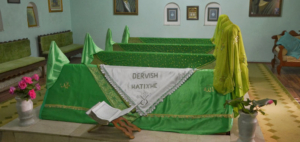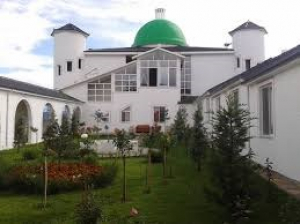Tekke Dervish Hatixhe
In a small lane in the Rruga Dervish
Hatixhe you can find the Bektashi Tekke of Dervish Hatixhe. It is not an
architecturally interesting building, but for those who would like to know more
about the Bektashi religion it is worth visiting it.
Hatixhe lived in the 18th century in this
district of Tirana and was a noted advocate for society’s weak people, women
and the sick, no matter what religion they belonged to, or what origin they
were. Through her work and profound social influence, she was awarded the
status of a saint. It is told of old of how she transformed her own home into a
hospital. During a cholera epidemic, she healed the sick without getting ill
herself and this was believed to be evidence of her spiritual power. Hatixhe
died in 1798 and her grave became a pilgrimage site for all those who believe
in her healing powers. The Tekke, built next to her grave is the most visited
sites in Tirana today, especially as a spiritual pilgrimage for women.
The Bektashi are a very open faith
community and all are welcome to visit the Tekke. When you enter the Tekke, on
the right side is a room lit with candles which you can buy at a kiosk at the
entrance of the little street. With the wax of the candle visitors write their
wishes and prayers on the walls of this room. In the opposite is the men’s
prayer room. It is the most used room in the building and is similar to a
mosque. Following the corridor, one enters the room of the tombs of the holy
Hatixhe, her brother and her children. Both in the prayer room, and in this
room you are required to take off your shoes before entering. In accordance
with Bektashi rules, you enter the room with the right foot first and circle
the graves three times. Believers kiss and touch the corners of tombs and the
paintings on the wall. The prayer is ended by kneeling and praying in front of
the Koran. Visitors leave the Tekke walking backwards, with their face towards
the tombs, being careful that one leaves the room with the left foot first.
Unlike other Tekke, the head of this Tekke
is extraordinarily a mother and not a father as is usual. They preach, pray,
and attend to the spiritual care of the faithful. If you like, you can sit on
the bench situated on the left side of the prayer room and just watch. Some
women put clothes of their loved ones on the graves and hope that the healing
powers of Hatixhe will be transferred to them.

